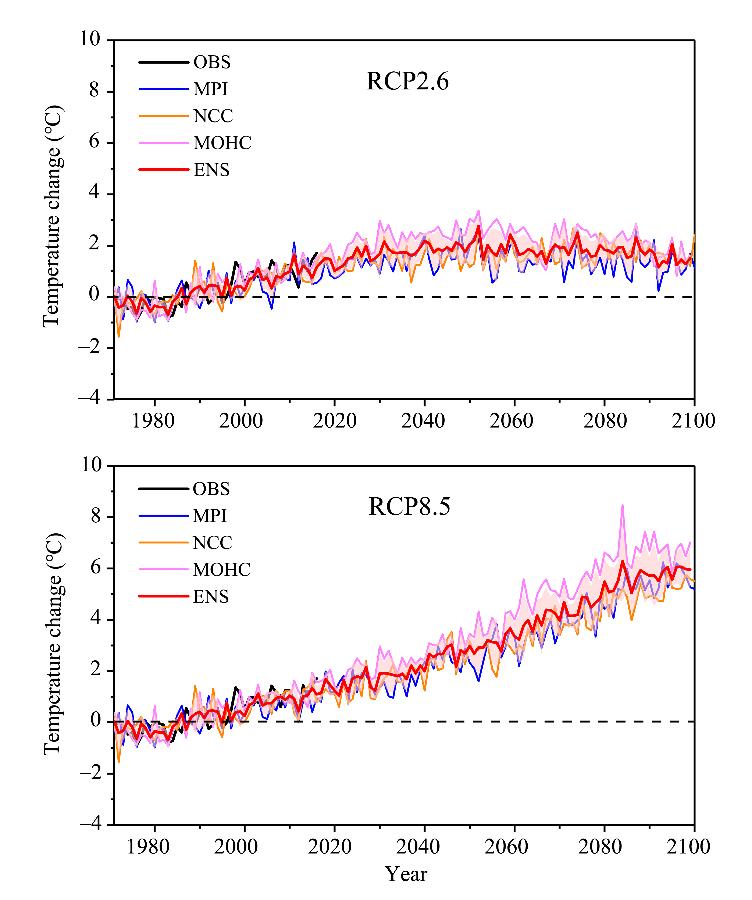As an important ecological security barrier in China, Qilian Mountain is the "water conservation area" of the key ecological function areas and is the birthplace of three major inland river basins: Shiyang River, and Heihe River, and Shule River. However, the Qilian Mountain Cryosphere continues to retreat due to climate warming. In the past 10 years, human activities such as excessive grazing, deforestation, and mining, have aggravated the ecological deterioration in Qilian Mountains. The water conservation function of the Qilian Mountains has been degraded, and the local ecological environment problems are very prominent, which have seriously affected the overall and long-term ecological service function and ecological barrier function of the Qilian Mountains. Among them, the downstream region is faced with the severe challenge of insufficient water resources for the sustainable development of the social economy. In this context, it is of great significance to estimate the future climate change in the Qilian Mountains. However, in the past, climate simulation and prediction tended to focus on China, western China, and the Qinghai-Tibet Plateau, and large-scale simulation analysis simply described the climate situation in the complex area of the Qilian Mountain, and detailed prediction for the whole Qilian Mountain is still lacking.
Based on this, Professor Gou Xiaohua’s team, College of Earth and Environmental Sciences, Lanzhou University, Key Laboratory of Western China Ministry of Education, used the German regional climate model REMO, which was used in the CORDEX-CORE framework of Coordinated Regional Climate Downscaling Experiment, to generate a 25km resolution simulation dataset driven by three different CMIP5 global climate models. Based on the evaluation of the simulated performance of the regional climate model from 1971 to 2000, the annual mean and seasonal temperature and precipitation changes in the Qilian Mountains during 2011-2100 under RCP2.6 and RCP8.5 scenarios are estimated. The results show that the REMO model can well simulate the spatial distribution and seasonal variation of air temperature and precipitation in the Qilian Mountains, with cold bias in air temperature simulation and wet bias in precipitation simulation, showing a warm and wet center around the lake. The results show that the temperature will increase significantly in the Qilian Mountains in the future. Under the RCP2.6 scenario, the warming rate will increase firstly and then decrease during 2011-2100, and the average warming rate will increase by 1.74°C during 2071-2100 relative to the reference period from 1971 to 2000 (Figure 1). Under the RCP8.5 scenario, the temperature will continue to increase from 2011 to 2100, and the average temperature rise will reach 5.36°C from 2071 to 2100. There are seasonal differences in future warming. Most of the warming occurred in winter under different scenarios in the three periods, and the warming in summer was the least in the medium and long term. The increase in annual precipitation in the region was not significant, and there was only a significant increase or decrease in a few years. The study says at the end of the century (2071-2100), two scenarios Qilian mountain precipitation increases obviously in winter and spring, and summer, autumn rainfall in eastern Qilian mountain will significantly reduce (figure 2), the area appeared (drought) will increase the risk of extreme weather, for the region's agricultural production and ecological system may produce great influence. This study provides a reference for ecosystem stability and sustainable economic and social development in the Qilian Mountains under the background of climate warming.

Figure 1. Annual mean temperature changes in the Qilian Mountains from 2011 to 2100 relative to 1971-2000 were driven by REMO simulations and ENS for three CMIP5 global climate models

Figure 2. Spatial distribution of REMO simulation and ENS were driven by three CMIP5 global models over the Qilian Mountains in 2071-2100 compared with 1971-2000
The study entitled "Projections of surface air temperature and precipitation in the 21st Century in the Qilian Mountains, Northwest China, Using REMO in the CORDEX” was published online in the Advances in Climate Change Research on April 8, 2022. Liu Lanya, a graduate student from the College of Earth and Environmental Sciences, Lanzhou University, is the first author of the paper, and professor Gou Xiaohua and Professor Wang Xuejia are the co-corresponding authors. The research work has been supported by the Strategic Priority Science and Technology Special Project of The Chinese Academy of Sciences (XDA20100102), the National Key RESEARCH and Development Program of China (2019YFC0507401), the Second Scientific Expedition and Research Program of Qinghai-Tibet Plateau (2019QZKK0208), the National Natural Science Foundation of China (41771068), ecohydrology and Inland The project was supported by the Key Laboratory of River Basin Science and Technology (KleIRB-ZS-20-04) and the Youth Innovation Promotion Association of Chinese Academy of Sciences (2018460).
Article links: https://doi.org/10.1016/j.accre.2022.03.003